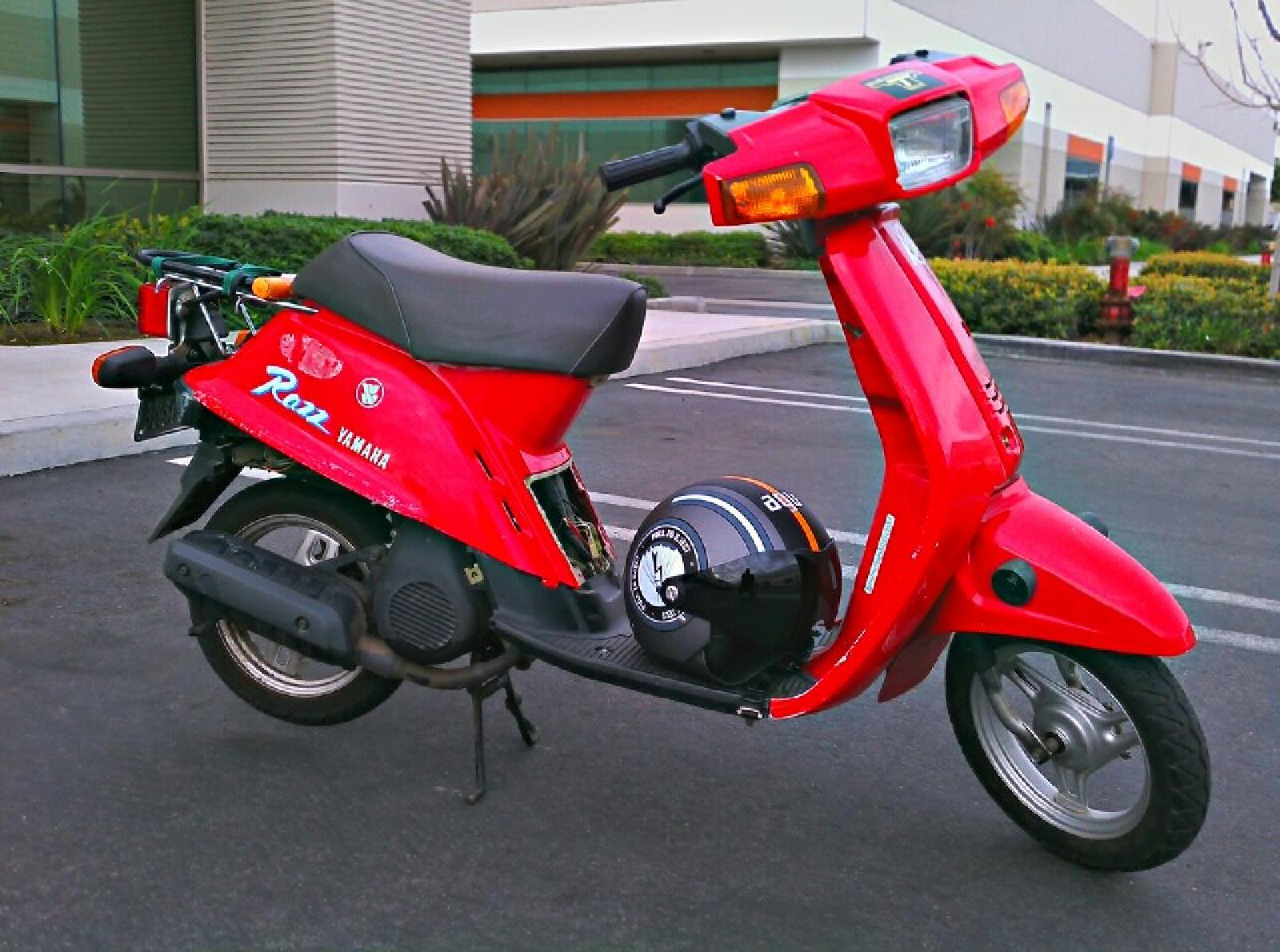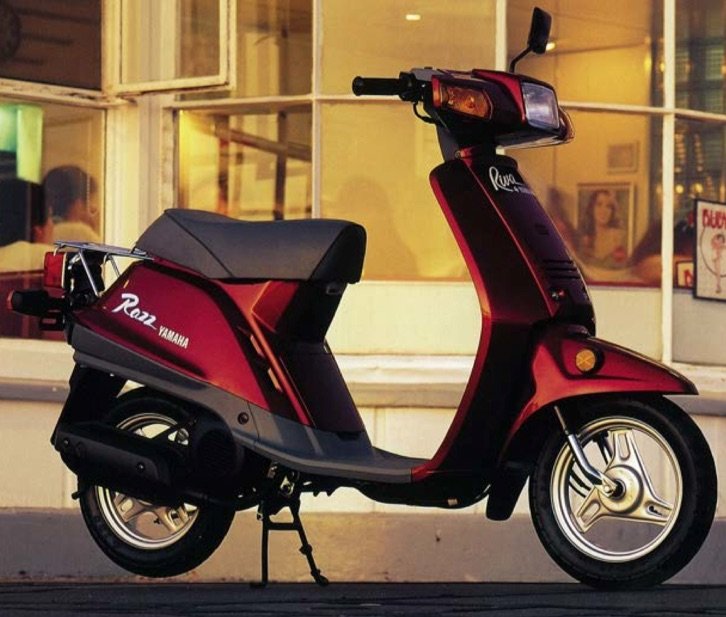YAMAHA RIVA RAZZ (SH50)
First introduced for 1987, the SH50 Razz was a nice little scoot from Yamaha that was released to replace the Salient / Riva 50 (CA50). The SH50 enjoyed an impressive 15 year run with 2001 being its last.
In Canada this scooter was called simply the Razz, while in the USA Yamaha chose to include it in their Riva family so they dubbed it the Riva Razz. In the final couple of years, Yamaha USA dropped the Riva prefix.
Motor
Since the Razz was Yamaha’s entry level 50cc scooter at the time (with the Jog being the higher end 50cc), it used a low cost version of Yamaha’s Minarelli engine. The Minarelli engine is a well designed air cooled, 50cc 2-stroke that is reliable and quite peppy. The Zuma and Jog utilized high end versions of this motor, while the Razz got a simpler version that lacked a continuously variable transmission (CVT) transmission and instead used a simpler single speed design. As a result, modifying a Razz to go faster is challenging because you’re stuck with just one fixed gear. In its stock form, the Razz tops out just over 30mph thanks to both its single speed gearing and detuned power. Yamaha reduced the output from the Minarelli for the Razz with a few tweaks like a lower compression ratio.
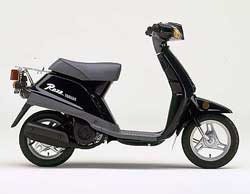
Design and Amenities
The Razz design in North America was pretty basic fare. It’s got a typical Japanese scooter look with the basic conveniences of a ‘modern scooter’ (automatic oil injection, electric start and auto choke). Beyond that there’s not too much to get excited about. There’s no storage or fancy touches anywhere on the Razz.
The brakes are basic drum stoppers, which is adequate for most riders considering the light weight of this scooter. The Razz was one of the lightest scooters available, weighing just 115 lbs dry. The Razz’s low weight contributes to its great milage, which Yamaha claims is 100mpg. Realistically, owners get about 80mpg in normal mixed use.
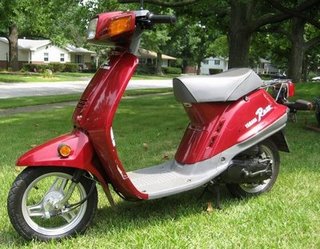
One downside to the Razz is that storage is non-existent. The gas tank and vertical Minarelli engine consume all the space under the seat and Yamaha opted to save costs by omitting any sort of a glovebox.
Yamaha did sell a few accessories for the Razz, specifically a windscreen, rear case and rear basket.
Discussion
The SH50 enjoyed a surprisingly long run from 1987 to 2001. That’s even more impressive when you consider that it was sold alongside other popular Yamaha scoots like the Zuma / BW’s and the Jog. It’s a well built and reliable scooter, but it does have a few downsides since it was intended to be as low cost as possible. The lack of storage will be an inconvenience for some, and the single speed gearing means you can’t easily speed up the Razz like you can with other Yamaha’s from this period.
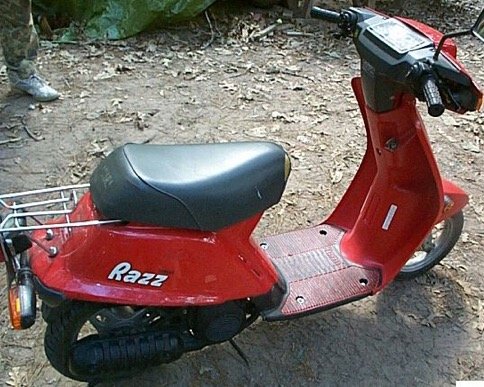
In its later years, the Razz really only competed with Yamaha’s own scooters (Jog and Zuma) and Honda’s Elite SR / LX. Back then there were no scooters from Italy, China or Taiwan to under cut the price of the Razz. In its last year, the Razz was $1549, which is likely close to double its original MSRP back in 1988 when it entered the USA.
Well taken care of Razz scooters remain reliable machines. They’re well suited for a low cost entry in the scooting world as long as you don’t need storage space or a high top speed. It’s also wise to avoid the Razz if you’re a bigger rider, as the drum brakes leave something to be desired and the physically small size of the Razz makes the cockpit a bit cramped.
Pros:
- OEM Parts widely available
- Decently peppy
- Lots of relatively new examples available
- Light
Cons:
- Limited aftermarket parts
- No storage
- Single Speed transmission
Links:
Official Razz Service Manual – Very helpful for working on your Razz scooter
MotorscooterGuide Forums – Visit the forum on this site to chat about this scoot
Razz Maintenance Table – Maintenance Info from Jacks Scooter Shop
Key Specs:
- Engine: Air-cooled 2-stroke
- Displacement: 49cc
- Bore & Stroke: 40.0mm x 39.2mm
- Fuel Delivery: 12mm Teikei Carb
- Compression Ratio: 6.3:1
- Starting: Kick and Electric
- Front Suspension: 1.6” travel, telescopic fork
- Rear Suspension: Single shock, 2.2″ travel
- Brakes: Drum front and rear
- Tires (Front / Rear): 2.50-10 / 2.50-10
- Dry weight: 115 lbs
- Length: 60.6″
- Width: 24.4″
- Height: 38.6″
- Seat Height: 27.8″
- Ground Clearance: 4.3″
- Wheelbase: 43.1″
- Fuel Tank: 4 litres (1.2 gallons)
- MSRP: $1549 (2001)
Colors:
- 1987: New White, Stormy Red, Coral Blue
- 1988: New Yamaha Black, Stormy Red, Coral Blue, Coral Pink
- 1989: New Yamaha Black, Stormy Red, Sweet Green, Coral Pink
- 1990-95: Mature Red, Glittering Black, Sweet Green, Coral Pink, Low Gloss Grey
- 1996-01: Very Dark Violet Cocktail, Deep Red Cocktail 2 (aka Maroon)

